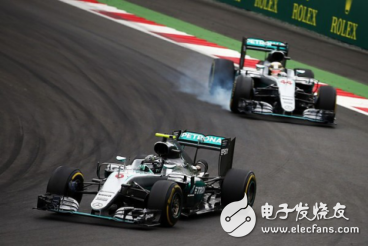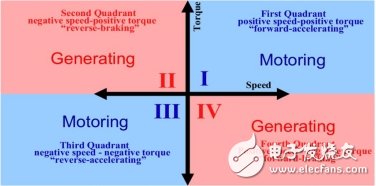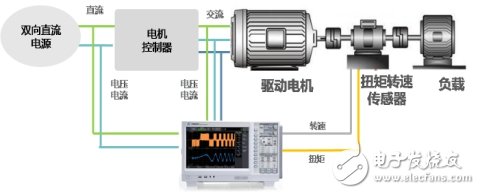The previous article has already introduced many of the characteristics of the motor. Today, I will talk about another feature of the motor: diligent and home!
In less than a month, the World Formula One Championship is about to start in 2017, and it is very exciting as a senior fan, so the topic we are discussing today starts from F1. Today's F1 stadium has undergone earth-shaking changes. The era of the McLaren Ferrari that once dominated the world has passed. With the three-pointed silver arrow team winning the championship again in 2016, the realization of the three consecutive championships announced the rule of Mercedes. The coming of the times. The success of the Mercedes-Benz team is inseparable from the reform of the engine power in the 2014 F1 rule.

Figure 1 ERS system starts to recover energy when F1 brakes
In 2014, the F1 rule reform introduced a new energy recovery system (ERS system), in which the kinetic energy recovery system (ERS-K) recovers the kinetic energy wasted from the brakes, and the car will be heavily braked, downhill, etc. during the race. And this state will generate extra kinetic energy or heat. For F1 cars, any Joule energy is precious, so if you can find a way to recover the kinetic energy generated by deceleration and downhill, you will enter the battery, then The energy of the battery is used to increase the turbine speed during the acceleration of the exit, and the faster exit acceleration is obtained, which is very important for winning the game. McLaren’s sluggish performance in recent years is due to the instability of Honda’s power and energy recovery system, so even if he is a world champion like Alonso, he still can’t get good results.
Can the tall energy recovery system be used on our civilian vehicles? The answer is yes. The significance of F1 is to make technical pre-research for civilian vehicles. Let me introduce the energy feedback on the electric car.

Figure 2 The dashboard shows the energy feedback process when the BYD E6 brakes
Most of the current electric vehicles use a permanent magnet motor or an AC asynchronous motor as the drive motor, and the drive is operated in the four quadrant (as shown in Figure 3). This is also a prerequisite for energy feedback. Electric vehicle deceleration is not just like a normal internal combustion engine decelerating after stepping on the brakes. Its braking principle is that when the brake is changed, the conduction phase of the excitation current is changed by the converter, and the motor generates a negative torque (ie, reverse rotation), and a large back electromotive force is generated in the coil winding, and the motor Actually generating electricity. The battery life of electric vehicles is very concerned by car manufacturers and users. Under the existing battery technology, the energy density of Panasonic 18650 lithium cobalt oxide battery used by Tesla is 233 watt-hours/kg, although it is called the battery life. Tesla, the highest mileage, is only 320 km long. So for electric cars, every joule of energy is also very important.

Figure 3 Motor four quadrant operation diagram
In GBT 18488.2-2015, the 7.6 section of the drive motor system standard for electric vehicles has a clear regulation on the feeding characteristics of the electric vehicle drive motor. The test method is as follows: the driven drive motor system is dragged by the prime mover and is in the feeding state. Record the DC bus voltage and DC bus current of the drive motor controller during the feeding process, drive the AC voltage of each phase of the motor, the AC current, and the rotational torque of the motor shaft end, and calculate the power and feed efficiency.
Since the national standard says that this feed characteristic is to be measured, how is the feed test of the drive motor measured? As a test expert in the domestic new energy field, Guangzhou Zhiyuan Electronics has given the test plan of the new energy vehicle drive system based on the difficulty of the feed system test of the new energy vehicle.

Figure 4 New energy vehicle drive system test architecture
As shown in Figure 4, the new energy vehicle driver is a DC bus-in, three-phase AC output mode. When the feed characteristic test is performed, the load motor drives the motor to be tested to rotate, so that the motor under test operates in the reverse power generation state. The generated three-phase power is converted into DC output by the driver, and the bidirectional DC power supply in the system returns the DC power back to the grid. Throughout the test, the power analyzer synchronously collects the data of the voltage and current and torque and speed sensors across the driver to calculate the feed efficiency.
Feeding characteristics experiment is just the tip of the iceberg in many test projects of new energy vehicles. Zhiyuan Electronics has long been focusing on new energy testing, and is committed to providing the most comprehensive testing solutions for domestic customers and contributing to the advancement of domestic new energy industry. !
All air springs are sourced globally from manufacturers to the original equipment market with IS9001 and TS16949 and certificates of conformity. All air spring mounting studs and air inlets are covered by protective caps. Where applicable, air springs are supplied complete with the relevant fitting kits.
Air springs are produced by a superior manufacturing process which is a reliable steam production method which gives extended service life, durability and constant quality to the rubber diaphragms.
Diaphragm And Airbag,Pneumatic Diaphragm Valve,Diaphragm Control Valve,Diaphragm Solenoid Valve
Shenyang Zhicheng Heavy Machinery Manufacturing Co., Ltd. , https://www.zhichengmachinery.com